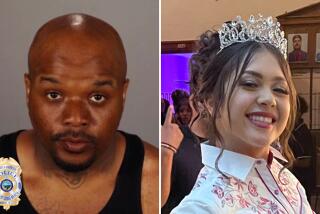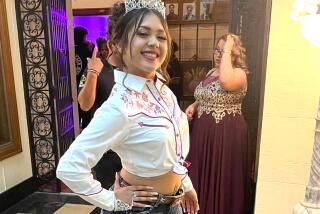Family Disputes Image of Slaying Victim : New York: Jenny Soto’s family paints a different portrait of the woman who was killed, apparently by a serial killer who preyed on prostitutes.
- Share via
NEW YORK — Two photographs of 23-year-old Jenny Soto hang side by side in her family’s living room. One is fresh-faced and childlike. The other shows a seductive woman, hands holding up her curly mane of hair in a pinup-style pose.
Those pictures, the family says, sum up the life of Soto, one of alleged serial killer Joel Rifkin’s apparent victims. Soto was a nice girl from Brooklyn, her sister said, who turned wild when she crossed the bridge into Manhattan, sometimes dabbling in prostitution. She also had a drug problem.
“She could look different at different times,” said her mother, Margarita Gonzalez, 49.
Seated on a plastic-covered couch in their cramped Brooklyn apartment, Soto’s mother, sisters and other relatives said Soto was struggling to make a better life when her body, clad only in a T-shirt, washed up on the rocks along the Harlem River in November.
“She straightened herself out,” said her 32-year-old sister, also named Margarita Gonzalez. “She wasn’t what they said she was.”
Soto was one of several young women, mostly prostitutes, who have been linked to Rifkin, 34, an unemployed gardener from Long Island who told police he killed 17 women from the metropolitan area.
Although Soto had a police record as a prostitute, her mother doesn’t want to believe it. She suggested Soto’s killer may have mistaken her for a prostitute because she “wore those short little skirts, those miniskirts.”
“She wanted to be a model and a dancer. She used to dress up nice and put on those big earrings,” she said.
Soto’s family painted a portrait of a vivacious party girl who went “into the city” to dance at clubs like Emerald City, the Palladium and the Ritz. She spent hours pulling her curly hair into a sleek French twist.
She liked rap and disco and was hoping to help produce for a rap group that her brother was in, her sisters said.
“We were out every night,” said Jessy Olmedo, Jenny’s 16-year-old sister. “She loved the clubs. She liked dressing up.”
She traveled with a fast crowd in Manhattan, her sister Margarita said. But showed a quieter side at home. She liked to play with her nieces and nephews and had four parakeets named after relatives: Pito, Yiya, Blanca and Christmas.
Soto’s immediate family includes her mother and six siblings, several of whom have different fathers. Their apartment is in a crumbling Brooklyn tenement. The rooms are small with cracked linoleum floors.
Mrs. Gonzalez moved to Brooklyn from Puerto Rico when she was 5 but still has some difficulty speaking English. She lives on welfare.
Soto’s father was also a murder victim, the family said. He was stabbed in the neck and back in a subway station in 1968, Mrs. Gonzalez said.
The family was angry and bitter about Jenny’s death.
“They should hang him,” said Mrs. Gonzalez. “If he were right here, I’d probably kill him.”
As she spoke, she stared up at the wall at two large color photographs of her dead daughter. She spoke in angry spurts, then fell silent and wiped away tears.
Until last Monday, when Rifkin was stopped for a traffic violation and police found a woman’s body in his truck, the families of victims now linked to him thought they were alone in their grief. Now they know they are not.
“They should give him an injection or put him in the electric chair and get rid of him fast,” said the younger Margarita Gonzalez. “But there’s nothing that can make up for the pain that he caused all these families. He shouldn’t be allowed to live.”
She said detectives told her that Jenny had fought her killer.
“She had pieces of skin under her fingernails,” her sister said. “And she had fake nails and those were ripped off when she fought him.”
More to Read
Sign up for Essential California
The most important California stories and recommendations in your inbox every morning.
You may occasionally receive promotional content from the Los Angeles Times.













